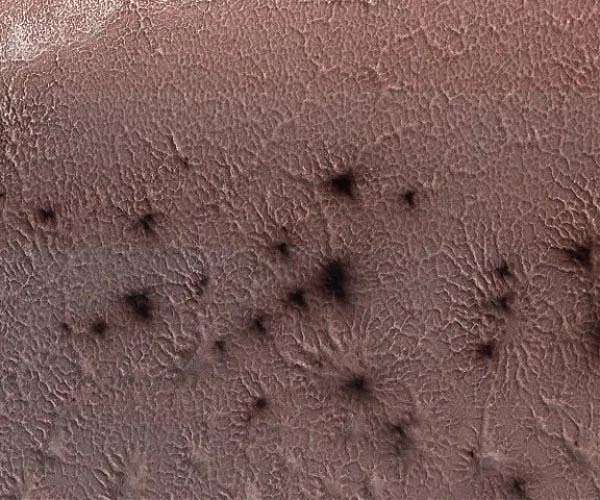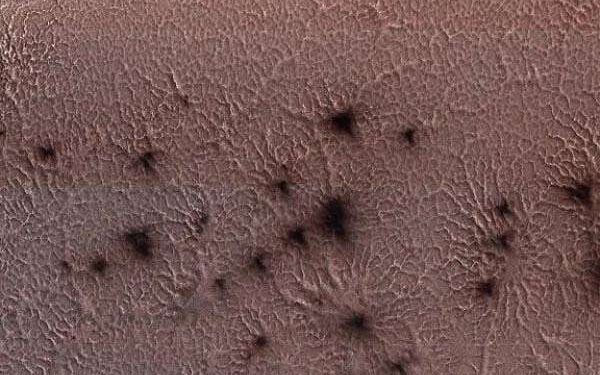
NASA recreates Mars’ Spider formations in lab for the first time
by Clarence Oxford
Los Angeles CA (SPX) Sep 15, 2024
NASA scientists have successfully recreated the mysterious spider-shaped formations found on Mars, providing new insights into how these unique geologic features form. The laboratory experiments were conducted under simulated Martian conditions, helping to confirm a theory that these “spiders” are carved by processes involving carbon dioxide ice.
First discovered in 2003 through orbiter images, these formations – known as araneiform terrain – have puzzled scientists. Located primarily in Mars’ southern hemisphere, each formation can span over a kilometer, with hundreds of branching legs that create a distinct wrinkled appearance on the Martian surface. Despite years of observation, their exact formation process remained unclear.
A study published in ‘The Planetary Science Journal’ offers fresh insights, thanks to experiments conducted in a specialized test chamber at NASA’s Jet Propulsion Laboratory (JPL). The findings confirm that the spiders are likely formed by sunlight heating the soil beneath transparent carbon dioxide ice slabs that accumulate each winter. As the soil heats up, the ice directly turns into gas, a process called sublimation, which leads to cracks in the ice and eruptions of gas. These eruptions lift dust and sand, leaving behind the characteristic spider-shaped scars.
“The spiders are strange, beautiful geologic features in their own right,” said Lauren Mc Keown of NASA’s Jet Propulsion Laboratory. “These experiments will help tune our models for how they form.”
Simulating Martian Conditions
One of the key challenges for Mc Keown and her team was recreating Mars’ polar surface conditions – extreme cold and low air pressure. To do this, the team used a liquid-nitrogen-cooled test chamber known as the Dirty Under-vacuum Simulation Testbed for Icy Environments (DUSTIE) at JPL.
“I love DUSTIE. It’s historic,” said Mc Keown, noting the chamber’s use in earlier Mars missions. For this experiment, the researchers chilled Mars soil simulant and then reduced the chamber’s air pressure to mimic that of Mars. Over several hours, carbon dioxide gas was pumped into the chamber, where it condensed into ice.
It took numerous attempts to perfect the experiment, but eventually, the team succeeded in creating the right conditions. Once the ice was thick enough, they used a heater to warm the soil beneath, causing the ice to crack. The result was a plume of gas, similar to the eruptions observed on Mars.
“It was late on a Friday evening and the lab manager burst in after hearing me shrieking,” Mc Keown recalled. “She thought there had been an accident.”
The plumes, which erupted for up to 10 minutes, left behind holes in the simulant – a close analog to the Martian spider formations. Interestingly, the experiment revealed an additional process not previously predicted: ice forming between the soil grains caused further cracking, contributing to the spider formations’ appearance.
Future Experiments and Ongoing Questions
Having successfully recreated these plumes in a lab, scientists now plan to simulate sunlight hitting the ice from above, rather than using a heater from below. This step will help refine their understanding of the conditions under which these formations occur.
Despite the success of these lab experiments, many mysteries remain. Why have the spiders formed in specific areas on Mars but not others? Are they remnants of a bygone Martian climate, or do they still form today? Scientists believe these formations might offer a glimpse into Mars’ distant past.
Currently, no Mars rovers are exploring the regions where these spider formations exist. The Curiosity and Perseverance rovers are located in other parts of the planet, and while the Phoenix mission once operated near the Martian north pole, it was unable to survive the harsh conditions for long.
For now, scientists will rely on lab experiments like these to better understand the Red Planet’s unique and evolving geology.
Research Report:A Lab-scale Investigation of the Mars Kieffer Model
Related Links
Mars at JPL
Mars News and Information at MarsDaily.com
Lunar Dreams and more
